Patient Cost Transparency Implementation Guide, published by HL7 International / Financial Management. This guide is not an authorized publication; it is the continuous build for version 2.0.0-draft built by the FHIR (HL7® FHIR® Standard) CI Build. This version is based on the current content of https://github.com/HL7/davinci-pct/ and changes regularly. See the Directory of published versions
| Page standards status: Informative |
This section of the Implementation Guide focuses on enabling a provider to submit a Good Faith Estimate (GFE) Packet including Good Faith Estimate resource profiles (Claim resources of type predetermination) along with supporting data (such as Patient, Coverage, etc.) to a payer. The payer can then use this information to generate an Advanced Explanation of Benefit (AEOB) Packet including Advanced Explanation of Benefits resource profiles (ExplanationOfBenefit resources of type predetermination) along with supporting data that the patient, and optionally the provider (GFE submitter on claim resources), can retrieve to get an estimation of costs for expected services as known at a specific point in time.
A primary goal of this guide is to enable the patient to have access to AEOBs for expected future medical items or services. Sharing this information with the provider is also supported as an option. This enables the provider to have an informed conversation with the patient to support better patient decision making. Payers sharing the same Patient AEOB with Providers will support trust in the Patient-Provider relationship for more informed health decisions and thus improved health outcomes. Sharing the same AEOB with providers also reduces burden for all parties because everyone is working from the same information avoiding miscommunication, inaccuracies, and added stress. If this capability is supported by the implementer, the patient’s AEOB will be provided to the GFE submitting provider using the same profiles in this guide. In this way the provider would receive the same information made available to the patient. This guide does not currently specify a means for providers to update or cancel a GFE submission. Rather, if there is new information that may materially affect the estimation, the provider would submit a new GFE Packet.
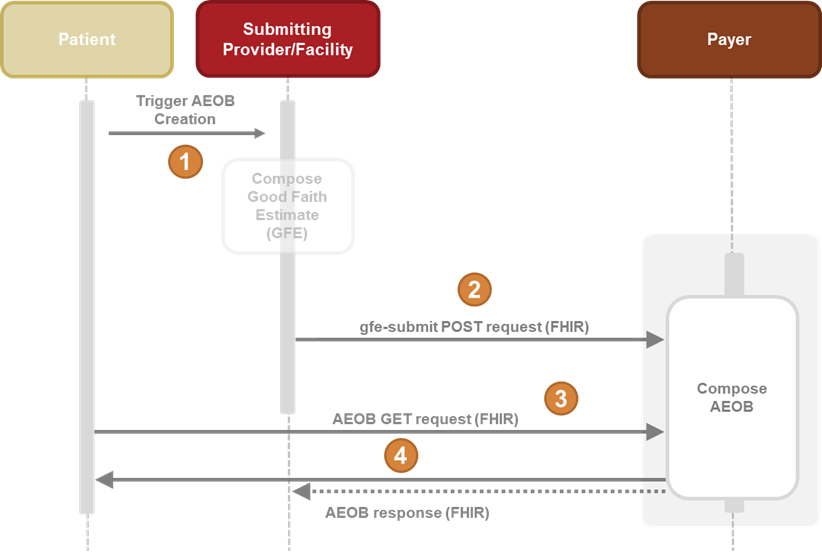
Figure 1: Advanced EOB Interactions Dotted line indicates optional.
GFE Submission and AEOB Diagram Steps (High Level View)
A patient schedules a service which triggers the composition of a collection of one or more GFEs. Note: The composition of the collection of GFEs is currently not in scope for this IG.
The collection of GFEs in the form of a FHIR resource bundle (GFE Packet) is submitted (via the gfe-submit operation) to the payer’s endpoint for AEOB creation.
The payer would then process, adjudicate, and produce the AEOB Packet.
The patient and provider may receive a notification of availability of the AEOB Packet and can now request and receive the AEOB Packet via FHIR query.
Note: Communication to the patient below could be through an app by a third-party or provider approved by the patient or directly to the patient by the payer.
Notifications may be handled using FHIR Subscriptions or other methods such as unsolicited notification or messaging. This IG provides requirements and guidance for the use of FHIR Subscriptions.
This IG utilizes the FHIR Subscriptions R5 Backport Implementation Guide as a basis to support FHIR subscriptions. That guide references a resource called SubscriptionTopic to express topics, or events that other systems can search for and subscribe to notifications of. The SubscriptionTopic resource is not supported by FHIR R4 systems. Instead, Subscription Topics in R4 can be defined using a Basic resource with extensions that represent the elements of the FHIR R5 resource. Neither standards based subscription topic discovery with the support of SubscriptionTopic nor the equivalent Basic resource versions described in the Subscriptions R5 Backport IG is required by this guide to support subscriptions. Regardless of whether the SubscriptionTopic or R4 Basic resource equivalent is supported, a system wanting to support subscriptions can still use the canonical URL of the SubscriptionTopic defined in this IG as the basis to define the nature of the subscription and may use it as the Subscription.criteria.
Notifications of AEOB Packet availability should be sent to the intended recipient (patient or provider(s)).
For the patients, this means the creation or update of a AEOB Packet Document Reference for which the patient is the DocumentReference.subject. This may be done through creating a compliant Subscription - AEOB Available for Subject Notification that references the SubscriptionTopic - AEOB Available for Subject Notification canonical URL of http://hl7.org/fhir/us/davinci-pct/SubscriptionTopic/davinci-pct-aeob-available-subject-notification.
For the Author(s) (Provider(s)), this means the creation or update of a AEOB Packet Document Reference for which the author (provider) is the DocumentReference.author. This may be done through creating a Subscription - AEOB Available for Author Notification that references the SubscriptionTopic - AEOB Available for Author Notification canonical URL of http://hl7.org/fhir/us/davinci-pct/SubscriptionTopic/davinci-pct-aeob-available-author-notification.
There may be one or more Author for the AEOB and Notifications can be shared directly to all authors through this means or to one Author (Convening Provider/GFE Submitter) who can then share the Patient AEOB with other contributing/co-providers as needed.
The subscriptions defined for Packet availability defined in this IG are for the DocumentReference resource. Generally, there should not be updates to an AEOB Packet (should be replaced). However, if updates are supported and there is a separate Bundle for the AEOB Packet content that is updated, the associated DocumentReference should be updated to trigger a notification.
Below are illustrations showing the relationships between the profiles involved in this workflow.
Note: For brevity, not all data elements are shown.
Figure 1 shows a GFE Packet that is submitted in the gfe-submit operation. It contains information about the patient, the payer and coverage information, and the GFE Bundles for processing.
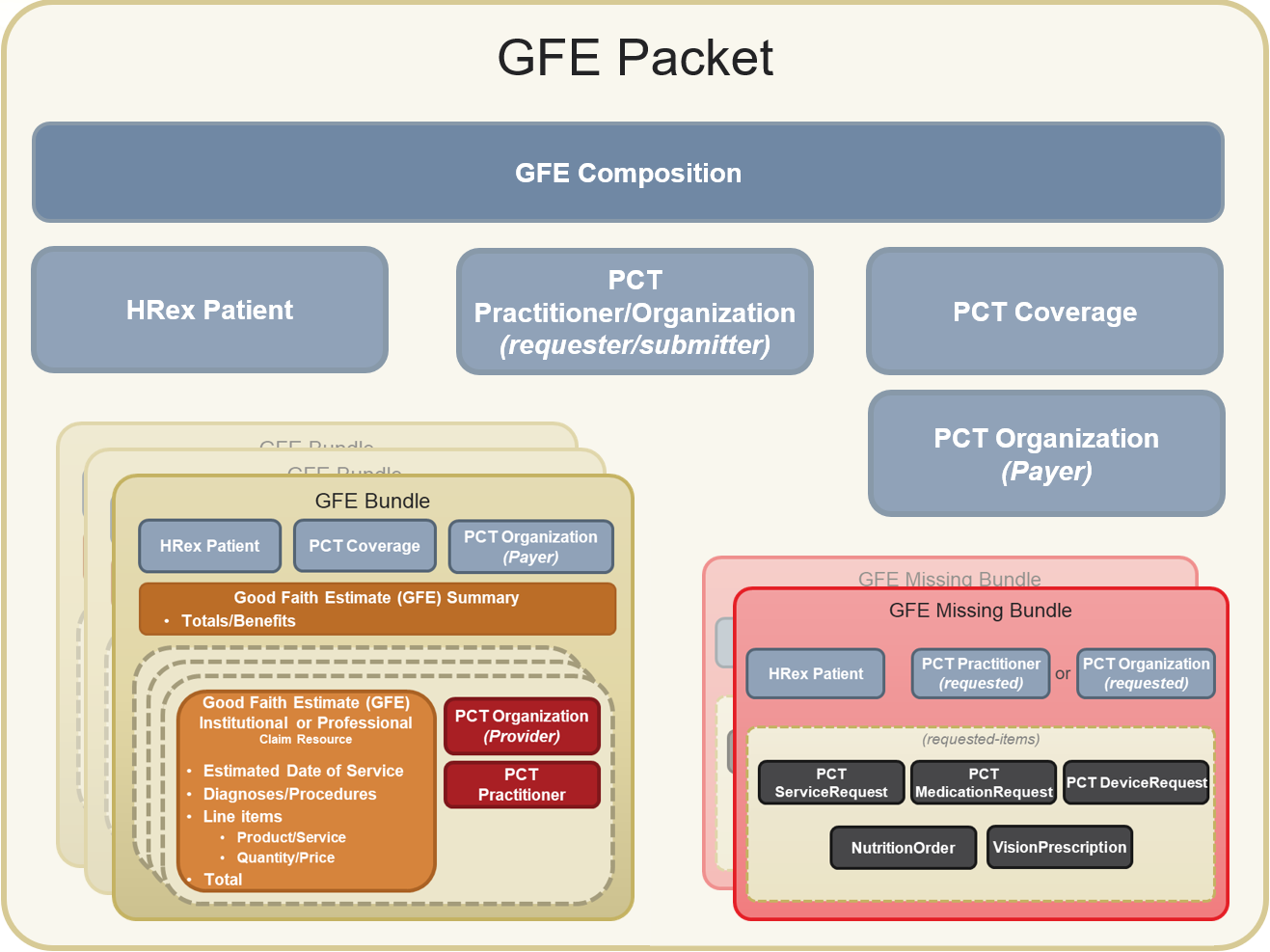
Figure 1. GFE Packet
Figure 2 shows the components of the GFE Bundle. It contains the Patient, Coverage and Payer if relevant, involved providers, and Claims data with the estimated costs. If the GFE Coordination Workflow was utilized, this is the same GFE Bundle as the one provided by a GFE Contributor. All resources (supporting info, etc.) needed to process the GFE and produce the AEOB SHALL be included in the GFE Bundle. Relevant resources referenced by such resources SHALL also be included.
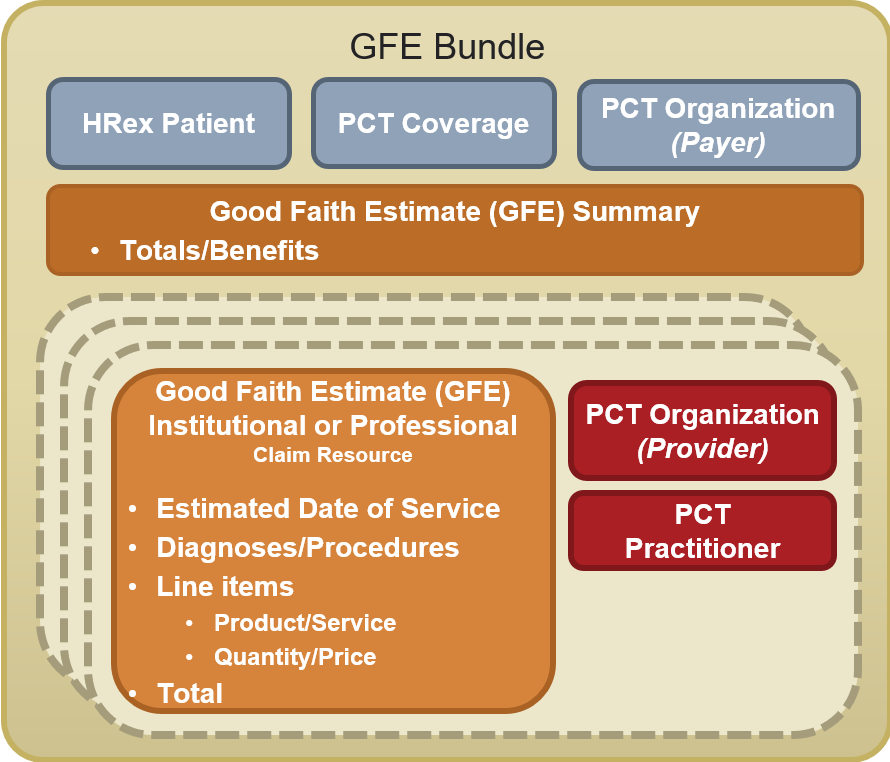
Figure 2. A GFE Bundle
Figure 3 shows an AEOB Packet created by a payer in response to a GFE-submit operation. The AEOB Packet SHALL contain one or more AEOBs. Each AEOB SHALL contain a reference to the original GFE Bundle (i.e., an exact copy of the originally submitted GFE).
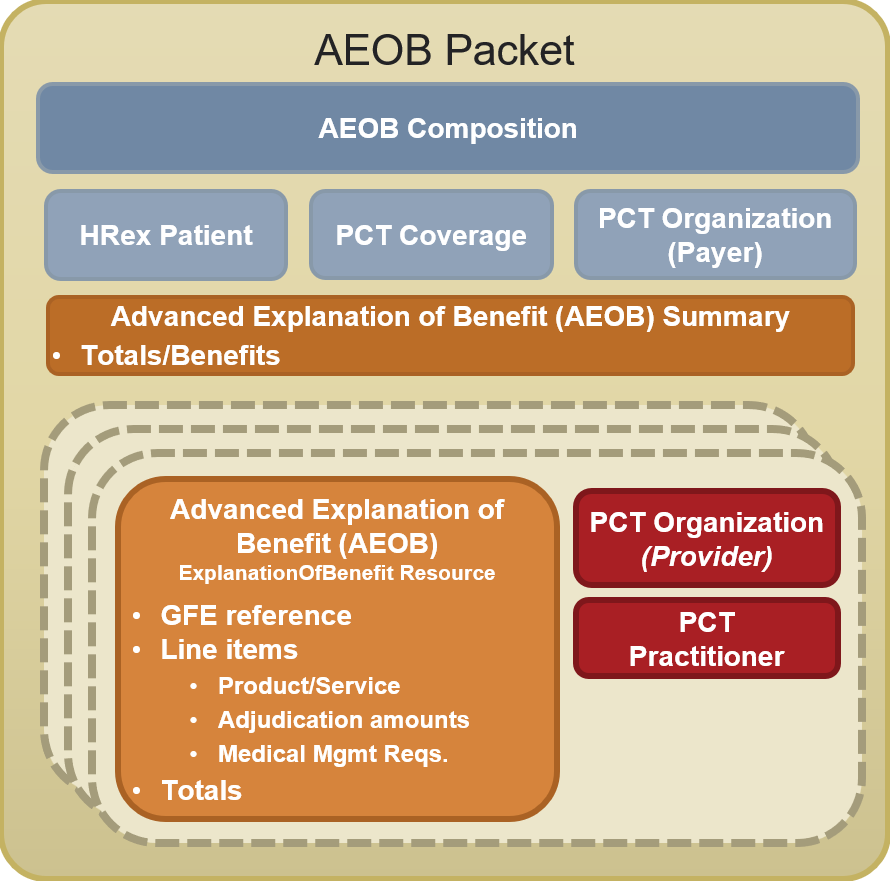
Figure 3. A AEOB Packet
The workflow diagram below describes the process of receiving a GFE Packet from the submitting provider and returning the completed AEOB asynchronously (or acknowledgement that the process was completed if the AEOB will not be returned to the provider), as well as the process for a patient app to query for and retrieve their completed AEOB.
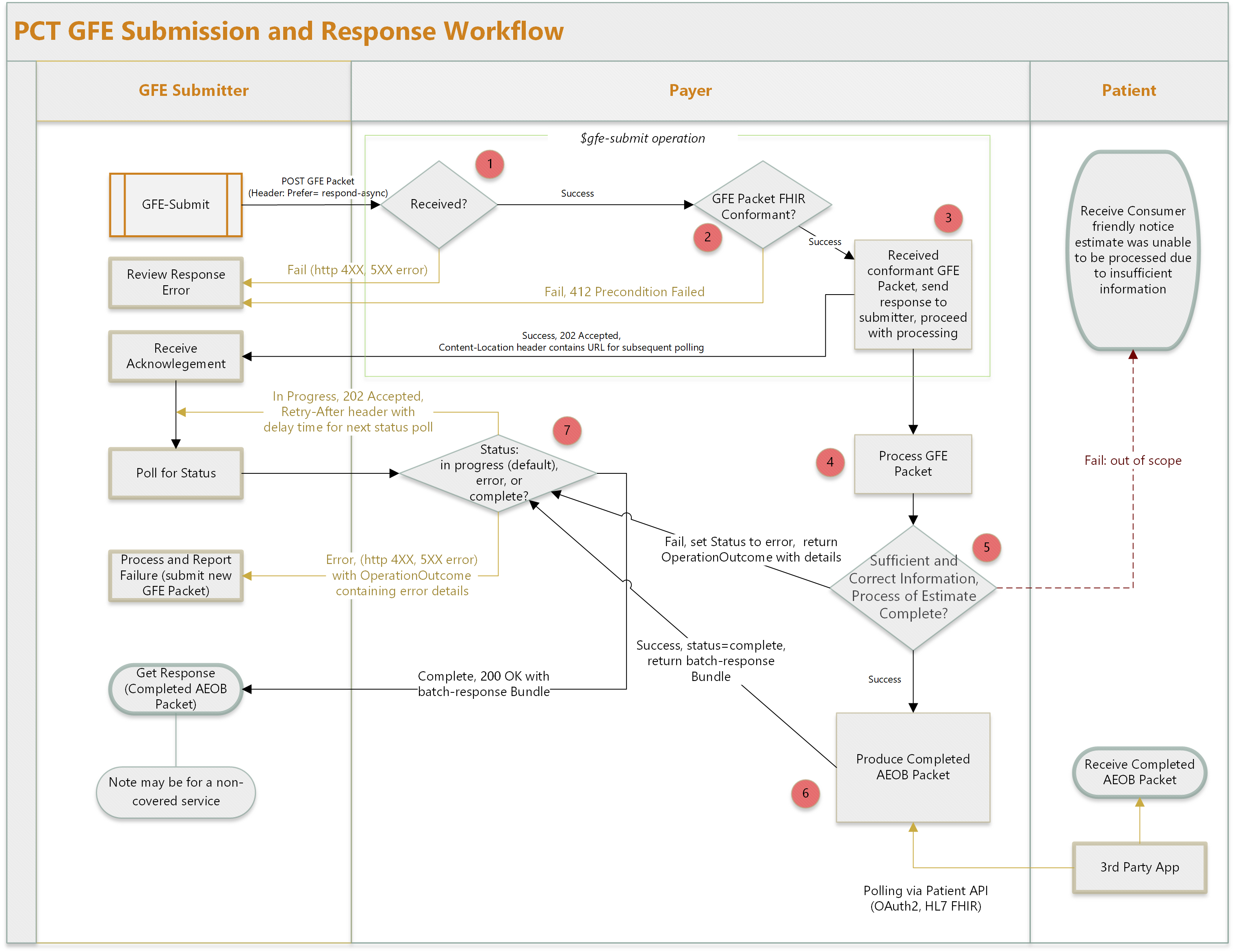
Figure 4: Payer Perspective: End-to-End Workflow
Note: The OperationOutcome Resource is a collection of error, warning, or information messages that result from a system action or operation like the one described here. More information about the purpose and use of the OperationOutcome resource can be found in the FHIR specification.
replaces relatesTo identifier that matches a previous GFE Submission identifier by the same submitter and the AEOB is not yet complete, the payer may assume that an AEOB response is no longer needed for the previous request and process the new request instead.The individual steps from the provider and patient perspective are detailed in the sections below.
A patient schedules a service and this triggers the composition of a collection of one or more GFEs, which the provider then submits to the payer for processing. Note: The composition of the collection of GFEs is currently not in scope for this guide.
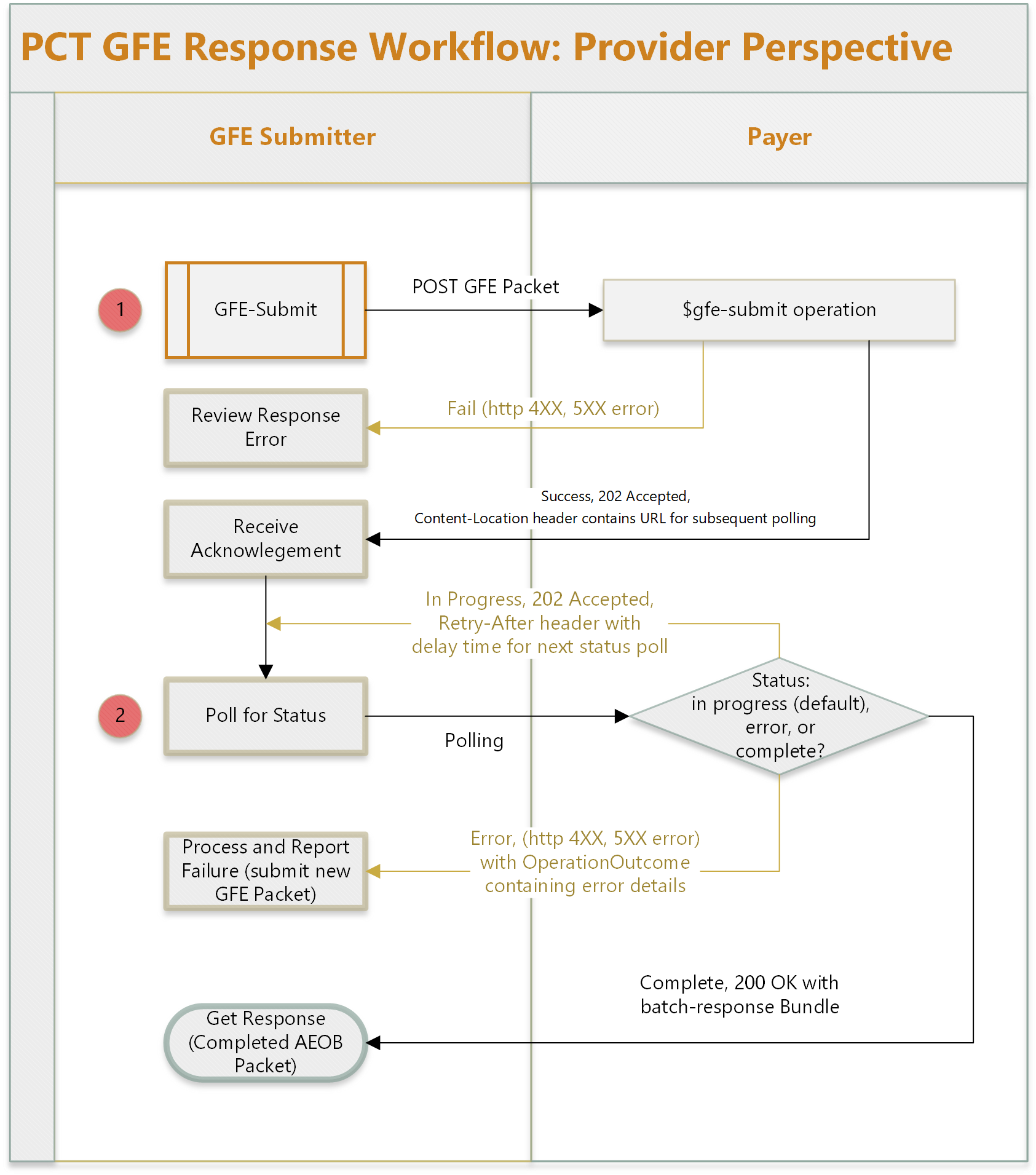
Figure 5: Provider Perspective
The patient has scheduled the service(s) with the provider(s). The payer may return the completed AEOB to the patient in many ways such as via mail, the payer patient portal, mobile app, or other technology to connect to the AEOB API. The only method in scope for this guide is the FHIR-based API approach inspired by the Patient Access API defined in the CARIN Consumer Directed Payer Data Exchange guide (CARIN IG for Blue Button). If the payer does implement both this API and the Patient Access API defined in the CARIN IG, it is up to the payer to determine if those APIs use the same or different endpoints.
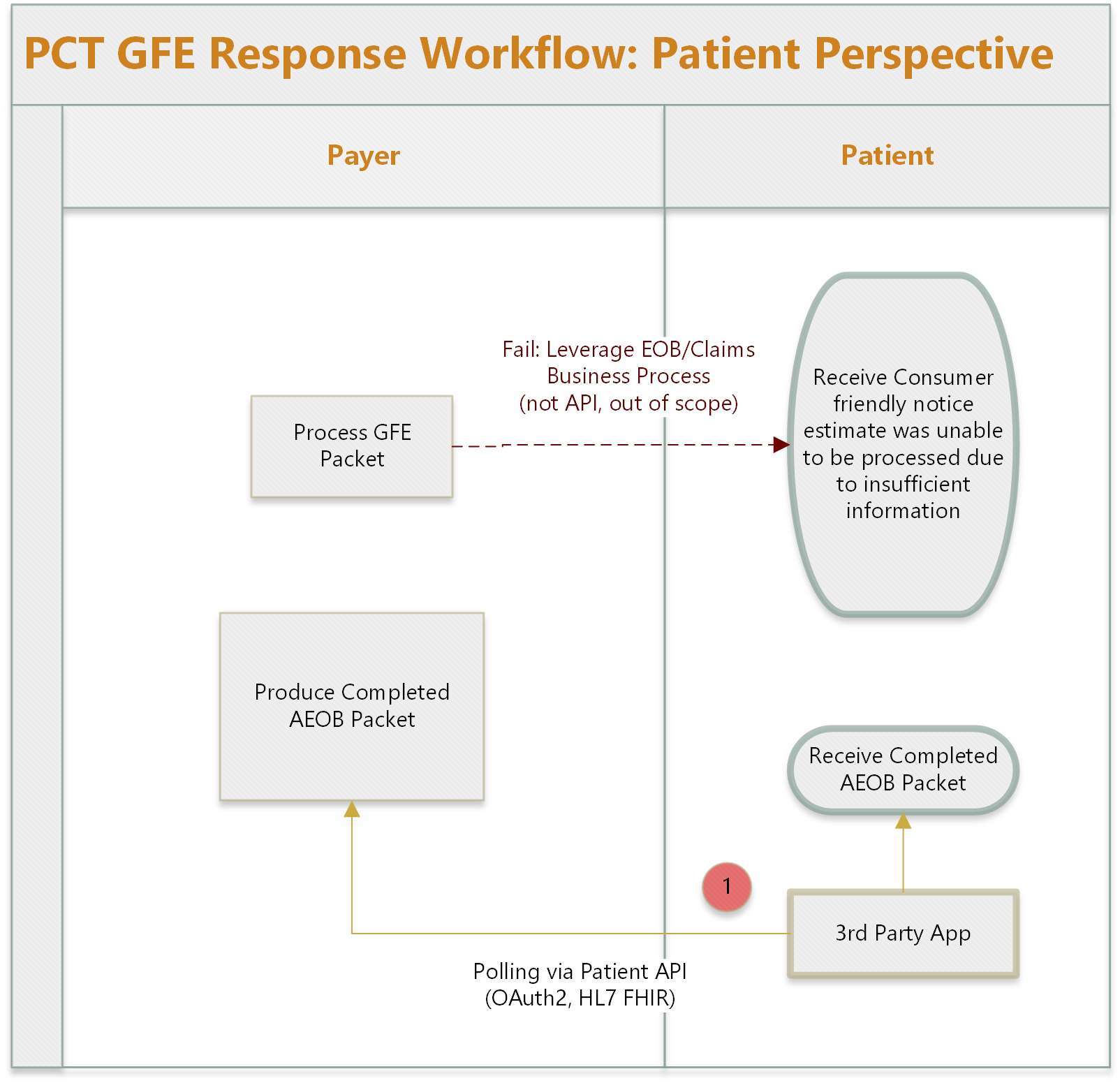
Figure 6: Patient Perspective
Note: If GFE processing fails, the payer may use existing business processes to notify the patient, but this is out of scope for this guide.
Waive NSA Rights Consent Example Scenario
The diagram below shows examples of how a patient may provide or withhold consent for No Surprises act Act protections using the balanceBilling extension on the GFE and how that could change the resulting AEOB from the payer.
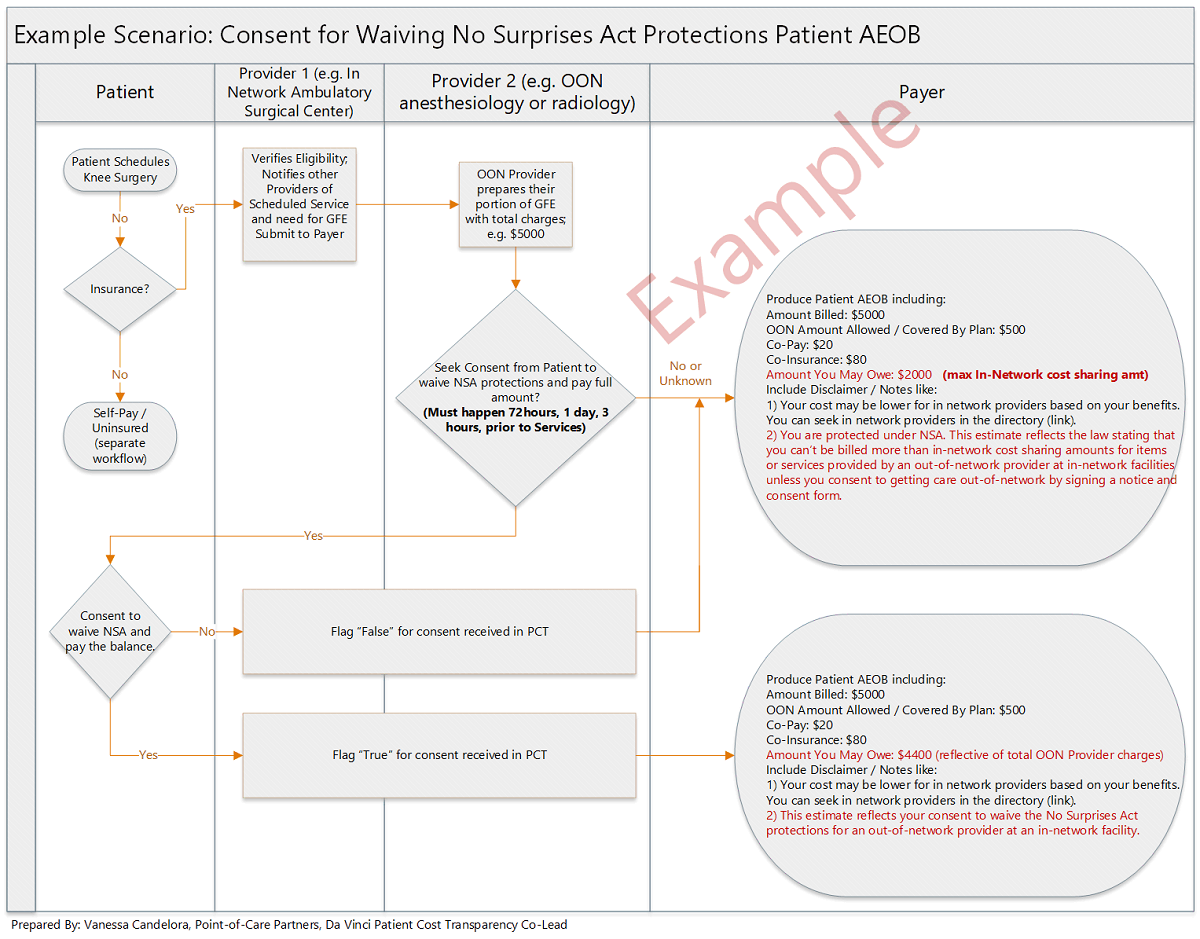
MRI Scenario
Assumptions:
• Patient has single commercial insurance coverage and plans to use it.
• This is clinically appropriate (Clinical Decision Support [CDS] Score).
• Service location is known (e.g., address).
• All providers are in network - PCP, imaging facility, and reading radiologist.
• While medical management techniques (such as prior authorization) will be included as a disclaimer when applicable in the AEOB returned to the member, the actual process of meeting medical management requirements is separate from the process of creating an AEOB. For details, see the Terms and Concepts section of this IG.